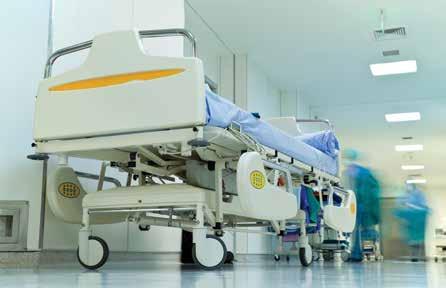
21 minute read
INDUSTRY POLITICS
RESILIENCE TOWARDS ECONOMIC RECOVERY
By Industry Update
Advertisement
As manufacturing acclimatises to the “COVID normal”, challenges such as disrupted supply chains, unstable staff retention and lower financial bottom lines persist.
As a result, Australia’s industry association AiGroup has pushed the Federal Government for stronger recovery strategies for the whole of Australia.
The August release of AiGroup’s Australian Performance of Manufacturing Index (APMI) indicate “broadly stable conditions” for the manufacturing sector overall nationwide.
The AiGroup’s Australian PMI is from combined indices of production, new orders, deliveries, inventories and employment data.
According to the AiGroup these results are gathered from a national sample of manufacturers and uses Australia/New Zealand classifications for manufacturing sub-sectors.
In August the Australia PMI dropped by 4.2 points with divergence between the main manufacturing states. Victoria has contracted significantly compared to other states due to the impacts of COVID-19.
Ai Group Chief Executive Innes Willox says,
"While the manufacturing sector held on to recent gains with activity broadly stable in August, manufacturers from Victoria, which accounts for about 25 percent of the national economy, sunk back into negative territory in the month.”
He adds this was in line with the introduction of severe restrictions on businesses and as local consumer demand was hit hard by the stay-at-home orders.”
However with positive news, the APMI also indicated some growth in the food & beverage, machinery & equipment, textiles, clothing, footwear, paper and in printing.
But Mr Willox did acknowledge that the “further fall in new orders cast a major shadow over conditions in the coming months.”
He adds a “further stimulus may be needed to help speed up the recovery in consumer and business spending.”
As we enter spring, daily COVID cases in Victoria are no longer in triple digits.
The first day of September saw 90 new cases – good news for the Victorian Government, which is relying on strict lockdowns to control the spread of infection.
During Parliament session, Premier Daniel Andrews’s request for an extension of Victoria’s state of emergency was ultimately granted at a reduced period of six months – half of what was originally proposed.
This reinforces concerns about the negative impact of lengthy COVID restrictions, particularly surrounding the closure of businesses and especially for those already struggling to keep up with the dynamic nature of COVID-19 risk management.
Since early August, Victoria has been under Stage Four lockdown. This involves curfews between 8pm and 5am across
metropolitan Melbourne in a bid to further curtail COVID community transmission.
The use of face masks for Victorian residents and businesses is also compulsory. At this point in time many of Victoria’s business operators are a step ahead putting COVID-19 Safety plans for their workplaces.
However some 13,000 tradie jobs have reportedly disappeared across the state, sliding seven per cent from pre-COVID levels. Overall consumer spending has reportedly dipped 22 per cent with cafes, fashion outlets and leisure spending among the worst hit.
On a national level, Australian consumer spending has dropped between three and five per cent.
Premier Andrews has announced further consultation with businesses and communities as part of Victoria’s roadmap to recovery towards “COVID normal”.
But Mr Willox says there is a need for the Victorian government to be well ahead with its business consultations on joint strategies towards economic recovery.
Premier Andrews says the Victorian government is doing its best to address buslness and industry concerns.
“We know every Victorian wants certainty about the future – for them, for their family and for their work,” he said.
“Workplaces will need to look very different as we found our "COVID normal". By working with business we’ll make sure that can happen practically and safely.”
The announcement towards the “COVID normal” was supported by Victoria’s Minister for Industry Support and Recovery Martin Pakula.
“We’ve said from the start that supporting our businesses will be crucial as we re-build that’s why we’re bringing them to the table as work continues on our future roadmap,” he says.
“Over the next few days, we’ll be talking through our COVIDSafe principles to ensure businesses can survive, adapt and most importantly, open up safely.”
AiGroup’s Mr Willox acknowledges that the outcomes won’t be immediate.
In a recent Federal Budget Submission they’ve identified important changes which are all hallmarks for building resilience.
These included:
- A clear return to business strategy that allows businesses and their employees to be ready for how and when activity can resume.
Boosting employment, skills, employability combined with wage support for new apprentices and trainees.
Program of skills assessment and adaptive training for displaced workers.
Improved funding for vocational education and training.
National program of wage support and incentives for cadets and interns in companies.
The increase of entrepreneurship, innovation and funded multi-partner industry training hubs.
AiGroup wants resources freed up to complement the JobKeeper and JobSeeker payments then believe have kept the economy going through the economic crisis.
The group wants the Government to demonstrate what success looks like, and to indicate what clear, evidence-based outcomes its is seeking to achieve.
In addition to business impacts, “the Government should adopt a balance of risk approach and, while taking health advice, give fuller consideration to other implications of lockdowns including on domestic violence levels, mental health, suicide rates, higher youth unemployment and long-term unemployment,” Willox says.
“ The risk-oriented approach should mean the removal of blanket COVID-19 restrictions.”
AiGroup recognizes that our economy is entering its first recession since the early 1990’s.
Mr Willox says the forthcoming Budget presents an opportunity to act on measures that will rectify the underlying weakness in the economy that were present prior to the COVID-19 crisis.
“Fortunately, our generally prudent approach to fiscal policy over many years means we are relatively well-equipped not only to manage the increased deficits and the greater levels of debt that have come with the COVID-19 crisis, but also to manage further stimulus in the 2020-21 Budget.”
The AiGroup wants fiscal strength to remain a priority, acknowledging that it will have its own challenges which will include reviewing Australia’s pattern of taxation.
Recognizing a potential budget deficit brought on by the current crisis, Mr Willox says it is still important not to “hold back on well-considered measures” to be able to move beyond the recession.
Specific to the Budget coming up AiGroup proposed the following changes:
To extend the term of the Coronavirus
Supplement and similar to stimulus packages introduced, provide a further
Economic Support Payment. Reductions in personal income tax to increase take-home pay thereby increase household spending.
AiGroup says that the upper threshold for the 19% tax rate can be lifted to $45,00;while reducing tax rates on incomes between $45-$90k to up to thirty percent.
They add that changes to the Low income tax offset (LITO) and Low and Middle Income tax offset (LMITO) can take place six months earlier than planned.
Mr Willox group’s proposal for helping the business community and the overall economy also includes boosting business cash flows, investment and employment by extending the reduction to 25 percent in the company tax rate.
The company tax rate is scheduled to take effect from next July for all companies with a turnover below $50million to those with a turnover of less than $1billion.
The business sector supported by AiGroup has also called for the federal government to work with states and territories to accelerate infrastructure and housing projects now in the pipeline.
Given that increasing R&D has also been pointed out as key strategy to facilitate moving to advanced manufacturing status; Mr Willox group also proposed the withdrawal of changes to the law which will cut back the coverage for the Research and Development Tax
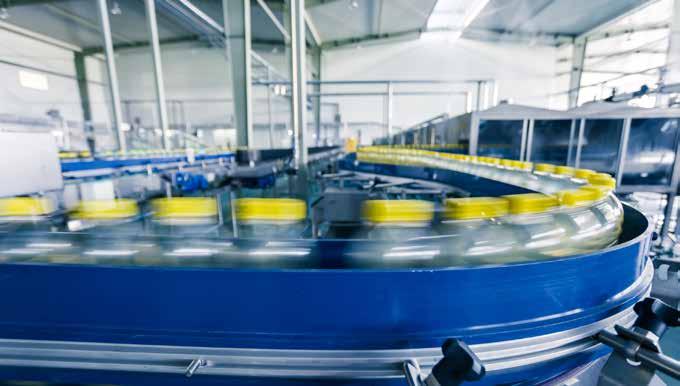
Incentive.
Scaling up energy efficiency and energy management technologies was a feature of Mr Willox’s team as proposal to government.
They say this can take place as an environmental objective through the allocation of $500million over 2 years for capital grants.
Mr Willox believes that at the minimum Australia should be able to become self-reliant with its own healthcare systems.
Identifying the pharmaceutical and medical technology sectors as important players he believes Australia’s health capacities should be the policymakers’ first objective.
“ Resilience doesn’t necessarily mean we have to make everything here. It does mean though that we can create potential to make many things here and give industry the opportunity to pivot quickly to make what we need as a country.”
Industry Update raised with Mr Willox that his organisation has been quite vocal about the way the Victorian Government has handled the covid outbreak in its state who they say have largely ignored issues and concerns of the business sector.
He thinks that the government may have over-reacted and has taken quite extreme measures in some of its approach with controlling covid transmission.
“It’s an over-reaction. Thousands of businesses have been able to operate their businesses for months even during the pandemic.
"They’ve put COVID safety plans in place but have not been able to implement it after shutdown. So this is creating economic and emotional stress.”
“It’s also creating unemployment. In August 66,000 jobs disappeared from Victoria. It will have massive economic consequences.”
The AiGroup has argued for a localised and more proportionate response to managing the pandemic. If NSW has been able to do it up to an extent, Victoria can learn from it.
“The government has over reacted and has not consulted more as widely as it should have. The result of that is there are businesses that could have operated and should still be opened and operated within covid safe practise capacities.”
“The reality is that many businesses are just barely hanging on and the need for the strict lockdown needs to be over.”
Finishing on a more optimistic note Mr Willox says he does acknowledge the importance of donning masks and its role in successfully keeping the covid spread within the 2-digit numbers in the state of Victoria.
He buys his supply of masks from a local Victoria manufacturer Sleep Corp Pty Ltd in South Victoria.
“ The mask manufacturing industry which is now fast expanding in Australia is a perfect example of how Australia can become stronger and a self-reliant advanced manufacturing country overall,” says the AiGroup’s head Mr Willox.
FACE MASKS UNMASKED
Love them or hate them, face masks have become a tenet of the “new normal” reality of life with COVID-19.
As the debate over whether to wear them or not continues to rage around the world, Industry Update has put together the most accurate information possible surrounding the use and efficacy of standard masks.
Controversies around mask use abound, from whether the wearing of masks should be made compulsory, to which masks should be worn (and on what occasion), and in what circumstances we should cover up.
As we go to print, the wearing of masks has become “strongly recommended” by the NSW public transport system, almost as important as social distancing inside trains and buses.
NSW Transport’s coronavirus travel advice says that the state is on high alert as a result of the recent increase in COVID-19 cases.
“Following NSW Health advice, wearing a face mask while using public transport is strongly recommended, as well as in other situations where it is difficult to maintain physical distance.”
The travel advice also details where and in what situations the wearing of face masks may become necessary: in “enclosed spaces where physical distancing is not guaranteed, such as buying groceries and customer-facing staff in hospital and retail.” PANDEMIC
As we progress through 2020 it’s become apparent that COVID-19 isn’t going to disappear quickly. Instead, we need to adapt to the new normal when it comes to surface cleaning and disinfecting.
Many of our customers are concerned about the risk of virus transmission via a contaminated surface. Some viruses cannot live for long outside a human or animal host, whereas others can survive for prolonged periods on contaminated surfaces.
Based on current information and published evidence, the coronavirus sits somewhere in the middle of the risk zone. Its ability to remain alive on surfaces is varied, making this virus even more challenging to remove. Thorough surface cleaning and disinfecting is imperative to ensure any potentially contaminated
The mask-wearing advice extends to areas where there is high community transmission such as places of worship.
Face masks are also strongly recommended – along with the practice of social distancing, hand washing and the use of sanitiser – when using taxis or rideshares.
Meanwhile, as winter continues to chill the nation, the COVID-stricken state of Victoria has begun to regulate compulsory wearing of face masks on account of its second wave of infections.
The rest of the country hasn’t gone that far, but like the rest of the world – especially those experiencing a second wave of the pandemic, such as the United States, India and Japan – Australia has become acutely conscious about the efficacy of masks.
Safe Work Australia is currently reviewing the wearing of masks and advises that the public refers to Department of Health guidelines.
For those among us who choose to wear face masks, the standard surgical mask is a common choice. For health workers attending to patients, the use of P2 and KN95 masks as part of Personal Protective Equipment (PPE) is a must.
So what’s the difference between a surgical mask and those required for use by health workers exposed to COVID cases?
Safe Work Australia differentiates surface is left in a clean and hygienic condition.
When cleaning a surface the first step is to physically remove all dirt and grime; this requires some elbow grease.
The surface you’re cleaning, whether floors, walls or benchtops, will determine which cleaning products to use. A good detergent or combination detergent and disinfectant is the right place to start.
Once the surface is clean, use a TGA-registered disinfectant that has been entered into the ARTG with specific claims against SARS-Cov-2 (COVID-19) or COVID-19 on the product label to disinfect the surface.
Viraclean is a hospital-grade disinfectant intended for use on a range of between a “cloth mask” and industry-required masks. Cloth masks are made from washable fabric like cotton and denim, and are worn by the general public in areas where there is community transmission and difficult-tomaintain physical distancing.
P2 and KN95 masks are about reducing respiratory exposure to airborne contaminants and are used when there’s high probability of transmission from particles and droplets in the air.
The two mask styles are recommended only for use in healthcare settings due to high demand caused by the pandemic.
The Victorian Government has declared that from August 2020, all Victorians “must wear a face covering when they leave home, no matter where they live.”
Safework NSW alerts users to check that masks purchased for work use meet Australian standards or the international equivalent. These include the manufacturer’s trade name and the mask filter’s classification. medical surfaces to better protect patients and staff from the risk of COVID-19 virus cross-infection.
Whiteley Corporation, a leading global innovator in infection prevention solutions, is now making Viraclean available to the wider market, including the manufacturing sector.
Effective surface cleaning, particularly of high-touch areas (doorhandles, benchtops) combined with good hand hygiene will assist in protecting your

It also points to an increase in “fake masks” brought on by demand and warns that misleading representations about masks can lead to a fine of up to $10 million as per Australian Consumer Law.
Australia’s only accredited face mask manufacturer is the family-owned Med-Con, based in Victoria. Med-Con, which has been providing products to the medical industry since 1989, has introduced “Level 2 and Level 3 face masks” which are rigorously tested for filtration efficiency and fluid resistance.
As guidelines surrounding mask wearing continue to change, Industry Update will stay on top of the issue and provide its readers with the latest information. Watch this space.
REFERENCES
• SafeWork NSW – safework.nsw.gov.au • Safe Work Australia – safeworkaustralia.gov.au • Department of Health – health.gov.au • WorkSafe Victoria – Worksafe.vic.gov.au
EFFECTIVE CLEANING DURING THE COVID
• Med-Con – medcon.com.au

staff. Ensuring hand sanitisers are easily accessible will assist in minimising the risk of infection.
Remember: to keep everyone in our community safe – including your staff – wash your hands regularly, socially distance, and when necessary, wear a mask.
Whiteley Corporation 1800 833 566 www.whiteley.com.au
MONASH PIONEERS SUPER FAST COVID TEST
In a world first, Monash University researchers have been able to detect positive cases of COVID-19 using blood samples in about 20 minutes.
Monash researchers were able to identify recent COVID-19 cases using 25 microlitres of plasma from blood samples. The discovery could advance the worldwide effort to limit the community spread of COVID-19 through robust contact tracing.
The research team, led by BioPRIA and Monash University’s Chemical Engineering Department (including researchers from the ARC Centre of Excellence in Convergent BioNano Science and Technology (CBNS)), developed a simple agglutination assay – an analysis to determine the presence and amount of a substance in blood – to detect the presence of antibodies raised in response to the SARS-CoV-2 infection.
Positive COVID-19 cases caused an agglutination or a clustering of red blood cells, which was easily identifiable to the naked eye. Researchers were able to retrieve positive or negative readings in about 20 minutes.
The assay could potentially be used to detect antibodies raised in response to vaccination to aid clinical trials.
Using a simple lab setup, this discovery could see medical practitioners across the world testing up to 200 blood samples an hour. Some hospitals with high-grade diagnostic machines could be able to test more than 700 blood samples every hour – about 16,800 each day.
“Detection of antibodies in patient plasma or serum involves pipetting a mixture of reagent red blood cells (RRBCs) and antibody-containing serum/plasma onto a gel card containing separation media, incubating the card for 5-15 minutes, and using a centrifuge to separate agglutinated cells from free cells,” says Dr Simon Corrie, one of the study’s leaders.
“This simple assay, based on commonly used blood typing infrastructure and already manufactured at scale, can be rolled out rapidly across Australia and beyond. This test can be used in any lab that has blood typing infrastructure,
which is extremely common across the world.”
Dr Corrie, along with Professor Gil Garnier and Professor Mark Banaszak Holl (BioPRIA and Chemical Engineering, Monash University) led the study, with initial funding provided by the Chemical Engineering Department and the Monash Centre to Impact Anti-microbial Resistance.
Researchers collaborated with clinicians at
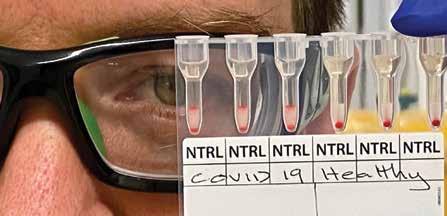
Monash Health to collect blood samples from people recently infected with COVID-19, as well as samples from healthy individuals sourced before the pandemic emerged.
Tests on 10 clinical blood samples involved incubating patient plasma or serum with red blood cells previously coated with short peptides representing pieces of the SARS-CoV-2 virus.
If the patient sample contained antibodies against SARS-CoV-2, these antibodies would bind to peptides and result in the aggregation of the red blood cells. Researchers then used gel cards to separate aggregated cells from free cells in order to see a line of aggregated cells indicating a positive response.
In negative samples, no aggregates in the gel cards were observed.
Professor Holl commended the work of talented PhD students in BioPRIA and Chemical Engineering who paused their projects to help deliver this game changing COVID-19 test.
“This simple, rapid and easily scalable approach has immediate application in SARSCoV-2 serological testing, and is a useful platform for assay development beyond the COVID-19 pandemic. We are indeblted to the work of our PhD students in bringing this to life,” he says.
“Funding is required in order to perform full clinical evaluation across many samples and sites. With commercial support, we can begin to manufacture and roll out this assay to the communities that need it. This can take as little as six months depending on the support we receive.”
COVID-19 has caused a worldwide viral pandemic, contributing to nearly 600,000 deaths and more than 13.8 million cases reported internationally.
TOUGH HYSTER LIFT TRUCKS EXTEND COST EFFICIENT PERFORMANCE
Hyster-Yale Asia Pacific is introducing its expanded family of Hyster UT series three-wheel lift trucks into Australasia.
The new Hyster UT electric range is ideal for multiple warehousing and logistics applications demanding high productivity over a broad range of simpler materials handling needs.
Hyster has expanded the range to include three-wheel forklifts in 1600- 2000kg capacity, pallet lift trucks in 1500kg capacity and stand-up and sit-down tow trucks in 3000-6000kg capacity respectively.
All are engineered to expand the longestablished strengths of the Hyster brand into wider markets seeking a quality, costefficient solution backed globally to meet users’ needs for applications requiring less frequent usage.
“The uncompromising levels of equipment in the new UT lift trucks includes the latest driver safety, comfort, manoeuvrability and drive features to emerging and growing applications such as warehousing, logistics (including 3PL), parts, hospitals and aerial platforms like the ones you see at hardware stores,” says Hyster-Yale Pacific area business director Mark Chaffey.
The latest additions to the UT family join Hyster’s four-wheel UT forklifts in bringing the performance of electric forklifts to emerging and growing market sectors seeking optimum cost-efficiency for their materials handling needs, says Chaffey, while still gaining Hyster’s long-established strengths of toughness, reliability, safety and strong service
Loading or unloading a crate from the top isn’t easy – unless you have a forklift or a crane.
Even then, getting crate to crane is not always a simple procedure depending on the layout of the site.
Pack King has responded by introducing a new range to its packaging and handling offerings: King Powered Floor Cranes.
With a King Powered Floor Crane, there’s no longer a need to take the forklift or overhead crane out of action for backing.
“The expanded family of UT electric lift trucks brings the broad range of Hyster brand advantages to these markets without paying for features users don’t need in their particular businesses.”
Features of the new lift trucks include:
Three-wheel electric lift trucks incorporate an ergonomically designed operator compartment laid out to help operators work comfortably in machinery engineered for drivers, with an outstanding range of compliance, performance, antifatigue and easy service features. Power options include wet cell batteries with single point watering or maintenancefree Lithium-Ion technology. Smooth, progressive high performance is provided by AC traction and hydraulic motors with electronic control. European-designed AC controllers coupled with AC traction and hydraulic motors allow for precise controllability. Compact dual-drive motors – one for each front wheel – feature precision-cut gears for reduced wear and lower noise levels. A small steering wheel facilitates fine control, with eight degrees of adjustment and low steering effort for operation in confined space. The low steering effort without kick-back facilitates precise positioning.
Hyster Seated T6.0UT and Standing T3.0UT electric tow tractors combine ergonomic and safety features with reliable performance from energy-efficient technology. Their low maintenance needs, easy access for routine servicing as well relocation when it’s time to unload. Simply power drive the crane to the destination, power extend and raise the crane jib to the required height.
From there, secure the slings around the safety hook and lift. To load a crate, reverse the process.
While floor cranes can initially be more cost-effective, the operator has to push or pull the crane and then add the load weight, all without control over the wheels. With the King Powered Floor Crane, brakes are applied as soon as the throttle is eased. as simple, readily available components provide increased productivity and reduced operational costs. Their safety and structural design also includes an ergonomic operator compartment, incorporating spacious non-slip floor plate and anti-vibration function on the T3.0UTS. The drive-axle design and low centre of gravity provides excellent stability of the T6.0UT, which also features Operator Presence System (OPS) and Emergency Stop buttons also featured on other members of the UT series family.
Hyster UT Electric Walkie Pallet Truck. The 24V sealed maintenance-free battery powered P1.5UT also combines economic operation with energy-efficient, low maintenance technology delivering reliable performance and increased productivity with reduced operation costs. With a small turning radius of 1.454mm and long handle to reduce steering effort, the P1.5UT increases productivity and safety by having castors to increase stability, entry rollers for easy operation, as well as strong performance on gradients,
Manual floor cranes can take dozens, if not hundreds of pump strokes to reach full height, and the extension boom must be set manually. The Powered Floor Crane raises and extends hydraulically, dramatically reducing manual labour.
Pack King offers four Powered Floor Crane models, all with 2500mm max boom extension and 3.5m lift height. Load weight ranges from 200kg to 1200kg dependant on boom pick-up length.
Powered Floor Crane legs are available in fixed width (or straddle), or splayed and extendable models.
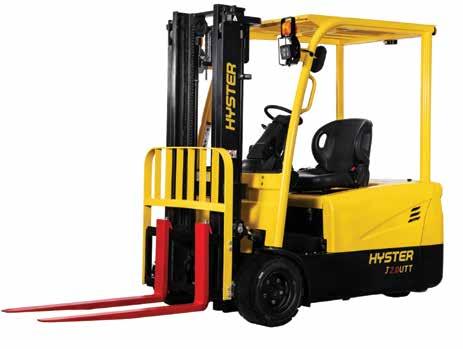
and when the tiller is upright, a reduction in turning space. The machine’s floating balance wheel automatically adjusts height and improves stability when unloading.
“The use of high quality and robust components, complemented by outstanding filtration and cooling, help provide reliability and low cost of ownership in a user-oriented truck,” Chaffey says.
“This, combined with fast availability of cost-effective replacement parts helps to curtail maintenance requirements and costs.”
If you prefer proven materials handling solutions backed by a supplier you can trust, Hyster meeds the need and makes the move.
Hyster-Yale Asia-Pacific Pty Ltd 02 9795 3842
PACK KING INTRODUCES POWERED FLOOR CRANES
www.hyster-yale.com
Whether you’re working with trucks and utes with awkward loads, picking up drums from pallets or even removing engines from vehicles, the King Powered Floor Crane puts power and safety back into loading and unloading.
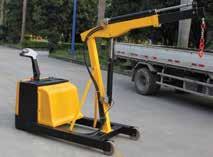
Pack King 0410 302 033 www.packking.com.au

